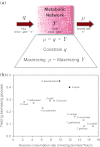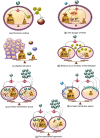Metabolic shifts: a fitness perspective for microbial cell factories
- PMID: 22936303
- PMCID: PMC3487007
- DOI: 10.1007/s10529-012-1038-9
Metabolic shifts: a fitness perspective for microbial cell factories
Abstract
Performance of industrial microorganisms as cell factories is limited by the capacity to channel nutrients to desired products, of which optimal production usually requires careful manipulation of process conditions, or strain improvement. The focus in process improvement is often on understanding and manipulating the regulation of metabolism. Nonetheless, one encounters situations where organisms are remarkably resilient to further optimization or their properties become unstable. Therefore it is important to understand the origin of these apparent limitations to find whether and how they can be improved. We argue that by considering fitness effects of regulation, a more generic explanation for certain behaviour can be obtained. In this view, apparent process limitations arise from trade-offs that cells faced as they evolved to improve fitness. A deeper understanding of such trade-offs using a systems biology approach can ultimately enhance performance of cell factories.
Figures



Similar articles
-
Improvement of microbial strains and fermentation processes.Appl Microbiol Biotechnol. 2000 Sep;54(3):287-301. doi: 10.1007/s002530000403. Appl Microbiol Biotechnol. 2000. PMID: 11030563 Review.
-
The concept of multiple-nutrient-limited growth of microorganisms and its application in biotechnological processes.Biotechnol Adv. 2003 Dec;22(1-2):35-43. doi: 10.1016/j.biotechadv.2003.08.006. Biotechnol Adv. 2003. PMID: 14623042 Review.
-
Old obstacles and new horizons for microbial chemical production.Curr Opin Biotechnol. 2014 Dec;30:101-6. doi: 10.1016/j.copbio.2014.06.009. Epub 2014 Jul 5. Curr Opin Biotechnol. 2014. PMID: 25000188 Review.
-
Towards biobased industry: acetate as a promising feedstock to enhance the potential of microbial cell factories.FEMS Microbiol Lett. 2018 Oct 1;365(20). doi: 10.1093/femsle/fny226. FEMS Microbiol Lett. 2018. PMID: 30239700
-
Environmental and cultural stimulants in the production of carotenoids from microorganisms.Appl Microbiol Biotechnol. 2004 Jan;63(4):351-61. doi: 10.1007/s00253-003-1441-1. Epub 2003 Oct 18. Appl Microbiol Biotechnol. 2004. PMID: 14566431 Review.
Cited by
-
Using drug-loaded pH-responsive poly(4-vinylpyridine) microspheres as a new strategy for intelligent controlling of Lactobacillus plantarum contamination in bioethanol fermentation.World J Microbiol Biotechnol. 2018 Sep 11;34(10):146. doi: 10.1007/s11274-018-2533-5. World J Microbiol Biotechnol. 2018. PMID: 30206729
-
Toward Multiscale Models of Cyanobacterial Growth: A Modular Approach.Front Bioeng Biotechnol. 2016 Dec 26;4:95. doi: 10.3389/fbioe.2016.00095. eCollection 2016. Front Bioeng Biotechnol. 2016. PMID: 28083530 Free PMC article. Review.
-
A General Process-Based Model for Describing the Metabolic Shift in Microbial Cell Cultures.Front Microbiol. 2020 Sep 30;11:521368. doi: 10.3389/fmicb.2020.521368. eCollection 2020. Front Microbiol. 2020. PMID: 33117301 Free PMC article.
-
Metabolic enzyme cost explains variable trade-offs between microbial growth rate and yield.PLoS Comput Biol. 2018 Feb 16;14(2):e1006010. doi: 10.1371/journal.pcbi.1006010. eCollection 2018 Feb. PLoS Comput Biol. 2018. PMID: 29451895 Free PMC article.
-
Effects of glucose availability in Lactobacillus sakei; metabolic change and regulation of the proteome and transcriptome.PLoS One. 2017 Nov 3;12(11):e0187542. doi: 10.1371/journal.pone.0187542. eCollection 2017. PLoS One. 2017. PMID: 29099858 Free PMC article.
References
-
- Aledo JC, del Valle AE. Glycolysis in wonderland: the importance of energy dissipation in metabolic pathways. J Chem Educ. 2002;79:1336. doi: 10.1021/ed079p1336. - DOI
-
- Angulo-Brown F, Santillán M, Calleja-Quevedo E. Thermodynamic optimality in some biochemical reactions. Nuovo Cim. 1995;17:87–90. doi: 10.1007/BF02451604. - DOI
Publication types
MeSH terms
Substances
LinkOut - more resources
Full Text Sources
Medical

